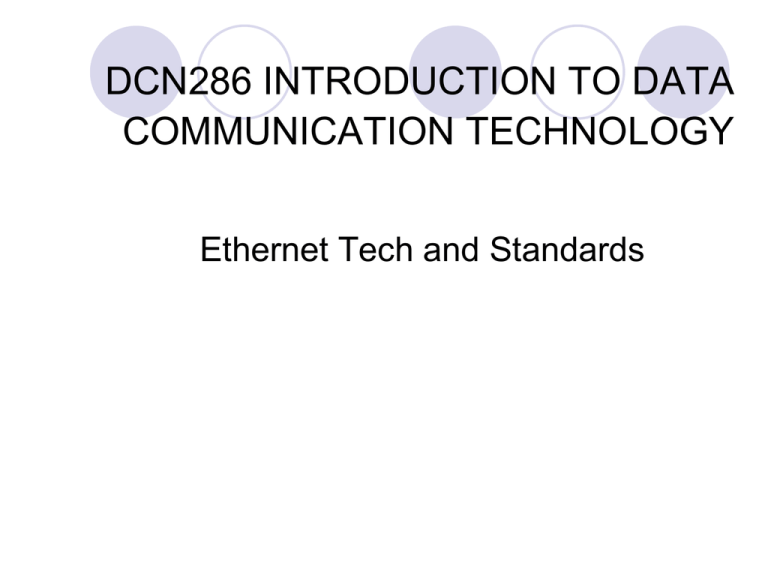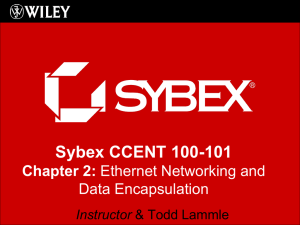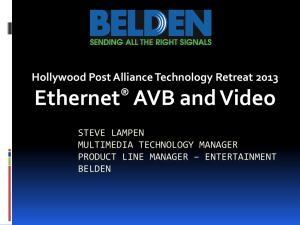Document
advertisement

DCN286 INTRODUCTION TO DATA COMMUNICATION TECHNOLOGY Ethernet Tech and Standards Outdated Ethernet 10Mbps Type Cabling Thin coaxial Max length of single cable 185m IEEE standard 802.3a 10Base2 10Base5 10Base-T Thick coaxial UTP 500m 100m 802.3 802.3i Logical bus topology CSMA/CD (Carrier Sense Multiple Access / Collision Detection) Half duplex operation with hub connection UTP cable categories UTP cable category Category 1 Purpose Comments Telephone Not suitable for data Category 2 Token Ring 4Mbps Token Ring Category 3 10Mbps Category 4 Telephone and 10BASE-T Token Ring Category 5 Ethernet Category 5e Ethernet 10BASE-T and 100BASET Same cable and connector. Support gigabit Category 6 Ethernet 16Mbps Token Ring Support 1Gbps. May support 10Gbps TIA/EIA568-A and B pin outs Pin # 1 2 3 4 5 6 7 8 Function TD+ TDRD+ Unused Unused RDUnused Unused 568A wire color White/Green Green White/Orange Blue White/Blue Orange White/Brown Brown 568 B wire color White/Orange Orange White/Green Blue White/Blue Green White/Brown Brown 100Mbps Ethernet (Fast Ethernet) Common Ethernet Timing Settings for 100Mbps Parameter Value Bit-time 10 nano-second (nsec) Slot time 512 bit-times (5.12 microseconds) Interframe spacing 96 bits Collision attempt limit 16 Collision backoff limit 10 Collision jam size 32 bits Max untagged frame size 1518 octets Min frame size 512 bits (64 bytes) 100BASE-TX IEEE802.3u defines the Fast Ethernet (100Mbps) with some common features: Can support CSMA/CD and half duplex Can disable CSMA/CD and support full duplex Support autonegotiation Use the same Cat5/5e cable and connector pinouts Same single cable length limitation (100m) Same Ethernet frame format Trunk link In a multiple switches environments, the link between switches is called trunk 100BASE-FX Fast Ethernet over optical fiber using 1300nm wavelength Was developed to overcome the limitation of 100m for 100Base-T Not as popular as FDDI or ATM Media Access Control (MAC) MAC Rules and Collision Detection/Backoff MAC Rules and Collision Detection/Backoff Fiber Distributed Data Interface (FDDI) (optional) Token Ring network using Token Bus timed token protocol Can support thousands of users Can extend range up to 200 km (124miles) Can achieve 200Mbps with double token rings Asynchronous Transfer Mode (ATM) (optional) Developed by ITU (International Telecommunications Union) and ATM Forum Packet switching protocol that encodes data into small fixed sized cells (Ethernet or IP has various length frames) @ 155Mbps Connection oriented model to establish virtual circuit between sender and receiver Transport real-time video and audio as well as image files, text and email over DSL lines Packet Switching and Circuit Switching (optional) 1.The Circuit switching is to have specific circuit between nodes for exclusive use during the communication session. One example is phone conversation. 2.The Packet switching is to transmit packets in the shared network and the specific path is not required. One example is mail system. You drop the envelope into the mailbox and do not care how the post office sends the letter to the destination. Gigabit Ethernet (1000Mbps) tech 1000BASE-T(IEEE802.3ab) 1000BASE-T (also known as IEEE 802.3ab) is a standard for gigabit Ethernet over copper wiring. 250Mbps per pair and the standard defines the way to simultaneously both send and receive over 4 pairs to achieve 1Gbps in each direction Can support half duplex and CSMA/CD though it is not practical. Supports up to 100m of 4-pair unshielded twisted pair (UTP) cable with RJ45 connectors. Common Timing Settings for 1000Mbps Ethernet Parameter Bit-time Slot time Value 1 nano-second (nsec) 4,096 bit-times (4.096 microseconds) Interframe spacing 96 bits Collision attempt limit 16 Collision backoff limit 10 Collision jam size 32 bits Max untagged frame size 1518 octets Min frame size 512 bits (64 bytes) Gigabit UTP cable The pinout is very similar to that specified in 568A/B. But, all 4 pairs would be required for bidirectional data transmitting. 1000BASE-TX Use only 2 pairs for communication. Cat6 and 7 cables are required. Different standard to 1000BASE-T 1000BASE-X Running over optic fiber Most popular standards are LX and SX Standard Cable type Max. cable length Transmitter Wavelength 1000BASE Multimode 220m -SX fiber Laser Short, typically 850 nm 1000BASE Single 5000m -LX mode fiber Laser Long, typically 1310 nm 1000BASE-LX (long) Longer cover range than SX Can reach 5 -20km.. Bigger wave length than SX Typically 1310nm (1270 to 1355 nm) 1000BASE-SX (short) Shorter cover range than LX Can reach 225 -550m. Smaller wave length than LX Typically 850nm (770 to 860 nm) SC connector The SC connector is a fiber optic connector with a pushpull latching mechanism which provides quick insertion and removal while also ensuring a positive connection. The SC connector has been standardized as FOCIS 3 (Fiber Optic Connector Intermateability Standards) in EIA/TIA-604-03. MT-RJ Connector The MTRJ connector is a small form-factor fiber optic connector which resembles the RJ-45 connector used in Ethernet networks. The MTRJ connector was designed by AMP, but was later standardized as FOCIS 12 (Fiber Optic Connector Intermateability Standards) in EIA/TIA-604-12. Optic fiber cable and converter Trendnet TFC-110S15 10/100Base-TX to 100BaseFX Single-Mode Fiber Converter with SC-Type Connector (15 km) Gigabit Ethernet 1000Mbps bidi media converter 10km SC connectors This Fiber Converter with SC-Type connector transforms 1000Base-T UTP/STP media to 1000Base-LX single-mode FIB1-T1R, T1(100ohms) to fiber optic media converter, SC, single mode 15Km, SNMP SC/SC SM Single mode fiber cable Panel (optional) Easy way to patch fiber cables to termination enclosures Advantage of optic fiber Noise immunity (optical fiber is free from EMI or RFI) Cabling distance is greater than UTP cable to meet demand of widely range No grounding is required Less electrical system requirement Immune to interception Disadvantage of optic fiber More challenge for cable installation Must use expensive optic fiber cable and connectors. Need for more expensive optical transmitters and receivers Additional tech skills and equipment would be required for installation, inspection and maintenance Cannot carry electricity to operate or power terminal devices 10 Gigabit Ethernet (IEEE802.3ae) Can run over optic fiber or UTP cable 10 giga bit per second Various standards Fiber (10GBASE-R) Standard Cable type Max. cable Transmitter Wavelength length 10GBASESR 10GBASELR Multimode 26-82m fiber Single 10-25km mode fiber Laser Laser Short, typically 850 nm Long, typically 1310 nm 10GBASE-T (IEEE802.3an) Can use UTP or STP cables. 10GBASE-T (IEEE802.3an) will use Cat6 /w RJ45 connector for 55m connection. It can reach 100m with Cat6a cable. Consume more power and has higher latency than other 10GBASE Ethernet physical layers. Ethernet Ethernet is the dominant LAN tech (8090% market share) What makes Ethernet so popular is its reliability, lower cost, and continued enhancements in speed, security, and connection quality. Future of the Ethernet 40 or 100 Gigabit Ethernet are in studying and working. 100Gbps, Terabit and 10Terabit would be possible in future. Question Any question? If you do not have question, please search internet and collect more information of those optic fiber cables, connectors and standards. 1. Please be comfortable to draw the shape of popular connectors. 2. Please be familiar with those organizations’ full name and main responsibilities.





